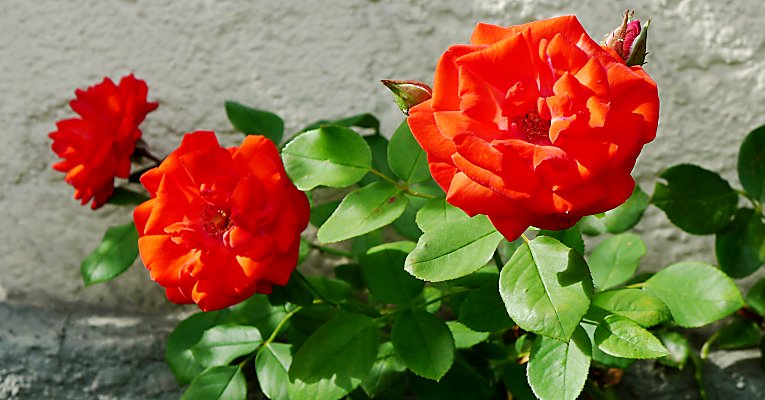General information about roses on walls
This is about cultivation, pruning and climbing aids for "wall roses". Yes, roses can also grow on walls! Our range is by no means limited to so-called climbing roses. Why? The term "climbing rose" is an arbitrary definition for varieties with long shoots that are suitable for pergolas and rose arches, but not necessarily for walls. They often even get sick on walls... Important to know: Almost all roses can also grow in containers! of a wall without any trellis.
Climbing rose - latin: Rosa

To Thrive...
Roses need a sunny location, but some varieties (especially those that are susceptible to mildew) may suffer from hot south-facing walls. Roses become stressed from around 30 degrees Celsius, and this temperature is quickly reached on a heated south-facing wall, and not just in midsummer! Therefore, only use trellises with an increased distance of 9 - 12 cm from the wall on such walls, or place the rose with a container and separate trellis only close to the wall, but do not attach the shoots to the wall. Partially shaded locations can also be considered. The soil should be sandy and loamy, deep, not too moist and also not dry, with some humus but not too nutrient-rich. Fertilise with potassium (potash) or wood ash until early in the summer. On hot days, water (additionally), otherwise the flowering splendour may be ruined for weeks. Distance between roses: 1.5 - 4 metres.
Characteristics and Pruning
Roses are ramblers: they grab onto branches or wires with their thorns to grow higher. Some cultivars tend to 'bald' (lose their leaves) at the base. Height of growth depends on the cultivar-- between 2 and 4 (15!) metres. The leaves persist from May to October, with some cultivars keeping their leaves well into March. The flowers open at the extremities of green shoots and come in many colours: yellow, white, pink, apricot, dark red... all shades in between. Some cultivars flower only once, some twice, and some for several months. Often produces green or red rosehip fruits.
The framework can be shaped depending on the growth habit of the particular rose. Generally speaking, the horizontal shoots will produce more flower buds and flower better in the following years. Cutting the older flowers stimulates the development of new flowers and can extend the flowering period. On smaller trellises, the rose can be cut down almost to the ground in winter. When cutting a shoot, always leave a small stub.
Climbing Supports for the Facade
Stakes, trellis grids, nets, or wire rope systems can be used for roses. The table at the bottom of the page lists compatible designs. Choose a wire rope trellis in the medium range, maybe even in the easy or light ranges for some, and a heavy or massive trellis for the more fragile cultivars or for larger projects.

Roses and Trellises
Roses are not twiners... rather they 'climb' by catching branches of other plants with their thorns; for this reason, they won't grow very high without a trellis / proper climbing support to pull them up. A horizontal training of the shoots is also a good, or even better, idea (see last 4 photos).
Suitable cable systems for climbing roses
Please click on the graphic illustrations for details!
| = suitable | = of limited suitability | = unsuitable |













































































































